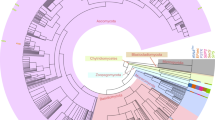Abstract
The essential micronutrient selenium is known to be used in a variety of biological processes in both prokaryotes and eukaryotes. The major biological form of selenium is selenocysteine, which is co-translationally inserted into selenoproteins. In the past decade, bioinformatics tools have been successfully developed to identify all, or almost all, selenoprotein genes in sequenced genomes. This chapter provides general information about currently known prokaryotic selenoprotein families and their major functions. In addition, recent comparative analyses of selenocysteine utilization and selenoproteomes across large groups of species offer important insights into evolutionary trends of different selenoprotein families and key factors that may influence selenoprotein evolution in prokaryotes.
Access this chapter
Tax calculation will be finalised at checkout
Purchases are for personal use only
Similar content being viewed by others
References
J Köhrle et al 2000 Biol Chem 381:849
SJ Fairweather-Tait et al 2011 Antioxid Redox Signal 14:1337
A Böck et al 1991 Mol Microbiol 5:515
TC Stadtman 1996 Annu Rev Biochem 65:83
DL Hatfield, VN Gladyshev 2002 Mol Cell Biol 22:3565
WP Tate et al 1999 Biochemistry (Mosc) 64:1342
J Donovan, PR Copeland 2010 Antioxid Redox Signal 12:881
L Johansson et al 2005 Biochim Biophys Acta 1726:1
A Böck 2000 Biofactors 11:77
S Yoshizawa, A Böck 2009 Biochim Biophys Acta 1790:1404
DM Driscoll, PR Copeland 2003 Annu Rev Nutr 23:17
M Rother et al 2001 Biofactors 14:75
C Allmang et al 2009 Biochim Biophys Acta 1790:1415
JE Squires, MJ Berry 2008 IUBMB Life 60:232
XM Xu et al 2007 Biol Trace Elem Res 119:234
D Behne et al 1990 Biochem Biophys Res Commun 173:1143
VN Gladyshev et al 1998 J Biol Chem 273:8910
BL Berg BL et al 1991 J Biol Chem 266:22386
GF Chen et al 1993 J Biol Chem 268:23128
Y Zhang, VN Gladyshev 2005 Bioinformatics 21:2580
Y Zhang et al 2005 Genome Biol 6:R37
Y Zhang, VN Gladyshev 2007 Nucleic Acids Res 35:4952
R Wilting et al 1997 J Mol Biol 266:637
GV Kryukov, VN Gladyshev 2004 EMBO Rep 5:538
Y Zhang, VN Gladyshev 2008 PLoS Genet 4:e1000095
BN Chaudhuri, TO Yeates 2005 Genome Biol 6:R79
VN Gladyshev et al 1994 Proc Natl Acad Sci USA 91:7708
JG Ferry 1990 FEMS Microbiol Rev 7:377
H Romero et al 2005 Genome Biol 6:R66
Y Zhang et al 2006 Genome Biol 7:R94
GM Lacourciere 1999 Biofactors 10:237
JA Vorholt et al 1997 Mol Microbiol 23:1033
E Garcin et al 1999 Structure 7:557
MX Sliwkowski, TC Stadtman 1988 Proc Natl Acad Sci USA 85:368
S Kreimer, JR Andreesen 1995 Eur J Biochem 234:192
M Wagner et al 1999 Eur J Biochem 260:38
S Jackson 2006 J Bacteriol 188:8487
UC Kabisch et al 1999 J Biol Chem 274:8445
B Söhling et al 2001 Biol Chem 382:979
MJ Kim et al 2015 Biochem Biophys Res Commun 461:648
T Stock et al 2010 Mol Microbiol 75:149
I Cózar-Castellano et al 2004 Biochim Biophys Acta 1700:179
PD Whanger 2000 Cell Mol Life Sci 57:1846
HY Kim 2013 Antioxid Redox Signal 19:958
HY Kim et al 2006 Biochemistry 45:13697
HY Kim et al 2009 Proteins 74:1008
Y Zhang, VN Gladyshev 2010 J Biol Chem 285:3393
EH Lee et al 2014 Arch Biochem Biophys 545:1
MJ Kim et al 2015 Biochem Biophys Res Commun 457:567
P Cravedi et al 2015 Genome Biol Evol 7:2692
M Mariotti et al 2015 Genome Res 25:1256
T Peng et al 2016 ISME J doi:10.1038/ismej.2015.246
Acknowledgements
This work was supported by the National Natural Science Foundation of China [NO. 31171233] and the Natural Science Foundation of Guangdong Province [No. 2015A030313555].
Author information
Authors and Affiliations
Corresponding author
Editor information
Editors and Affiliations
Rights and permissions
Copyright information
© 2016 Springer Science+Business Media, LLC
About this chapter
Cite this chapter
Zhang, Y. (2016). Prokaryotic Selenoproteins and Selenoproteomes. In: Hatfield, D., Schweizer, U., Tsuji, P., Gladyshev, V. (eds) Selenium. Springer, Cham. https://doi.org/10.1007/978-3-319-41283-2_12
Download citation
DOI: https://doi.org/10.1007/978-3-319-41283-2_12
Published:
Publisher Name: Springer, Cham
Print ISBN: 978-3-319-41281-8
Online ISBN: 978-3-319-41283-2
eBook Packages: Biomedical and Life SciencesBiomedical and Life Sciences (R0)




